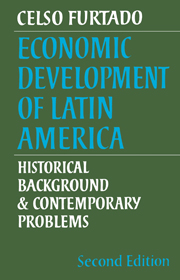Book contents
- Frontmatter
- Contents
- Tables
- Preface to the second edition
- Preface to the first edition
- Abbreviations
- Maps
- PART ONE FROM THE CONQUEST TO THE FORMATION OF NATION-STATES
- PART TWO ENTRY INTO THE SYSTEM OF INTERNATIONAL DIVISION OF LABOUR
- PART THREE THE TRADITIONAL STRUCTURAL PATTERN
- PART FOUR CHARACTERISTICS OF THE INDUSTRIALISATION PROCESS
- 10 The industrialisation process. i: The initial phase
- 11 The industrialisation process 2: Import substitution
- 12 Imbalances created by import-substituting industrialisation: structural inflation
- PART FIVE REORIENTATION OF DEVELOPMENT IN THE RECENT PERIOD
- PART SIX INTERNATIONAL RELATIONS
- PART SEVEN INTRA-REGIONAL RELATIONS
- PART EIGHT STRUCTURAL RECONSTRUCTION POLICIES
- Bibliography
- Index
10 - The industrialisation process. i: The initial phase
Published online by Cambridge University Press: 25 January 2010
- Frontmatter
- Contents
- Tables
- Preface to the second edition
- Preface to the first edition
- Abbreviations
- Maps
- PART ONE FROM THE CONQUEST TO THE FORMATION OF NATION-STATES
- PART TWO ENTRY INTO THE SYSTEM OF INTERNATIONAL DIVISION OF LABOUR
- PART THREE THE TRADITIONAL STRUCTURAL PATTERN
- PART FOUR CHARACTERISTICS OF THE INDUSTRIALISATION PROCESS
- 10 The industrialisation process. i: The initial phase
- 11 The industrialisation process 2: Import substitution
- 12 Imbalances created by import-substituting industrialisation: structural inflation
- PART FIVE REORIENTATION OF DEVELOPMENT IN THE RECENT PERIOD
- PART SIX INTERNATIONAL RELATIONS
- PART SEVEN INTRA-REGIONAL RELATIONS
- PART EIGHT STRUCTURAL RECONSTRUCTION POLICIES
- Bibliography
- Index
Summary
Industrialisation induced by expansion of exports
In countries specialising in primary production for export, that is, countries in which productivity was raised in response to the expanding world demand for raw materials, the change in the structure of production particularly the process of industrialisation, is characterised by a number of distinctive features which constitute one of the most interesting aspects of the economic theory of underdevelopment. The rise in productivity and the consequent increase in the purchasing power of the population led to diversification in the pattern of overall demand involving also a more than proportionate rise in the demand for manufactured products. It has been observed that in countries with a per capita income level below 500 US dollars there is a high income-elasticity of demand for manufactured goods, the coefficient value being between 1.3 and 1.5. Hence any rise in the population's purchasing power will mean not only diversification of demand but diversification in a particular direction, requiring a more than proportionate increase in the supply of manufactures. Since specialisation in primary exports (almost invariably only one or two products) concentrates resources in a few lines of production, the evolution of the productive structure will be the inverse of that of the demand schedule.
- Type
- Chapter
- Information
- Economic Development of Latin AmericaHistorical Background and Contemporary Problems, pp. 100 - 106Publisher: Cambridge University PressPrint publication year: 1977



